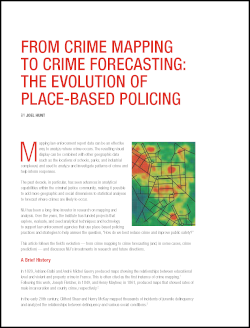
Mapping law enforcement report data can be an effective way to analyze where crime occurs. The resulting visual display can be combined with other geographic data (such as the locations of schools, parks, and industrial complexes) and used to analyze and investigate patterns of crime and help inform responses.
The past decade, in particular, has seen advances in analytical capabilities within the criminal justice community, making it possible to add more geographic and social dimensions to statistical analyses to forecast where crimes are likely to occur.
NIJ has been a long-time investor in research on mapping and analysis. Over the years, the Institute has funded projects that explore, evaluate, and seed analytical techniques and technology to support law enforcement agencies that use place-based policing practices and strategies to help answer the question, “How do we best reduce crime and improve public safety?”
This article follows the field’s evolution — from crime mapping to crime forecasting (and, in some cases, crime prediction) — and discusses NIJ’s investments in research and future directions.
